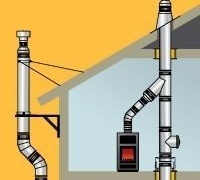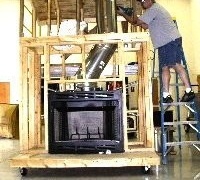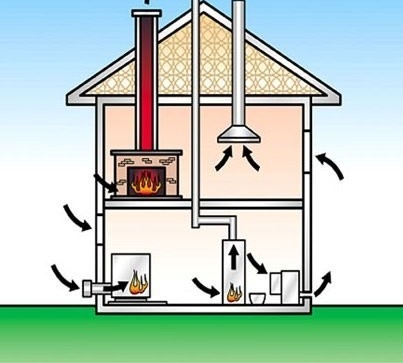Coaxial chimney device and standards for its installation
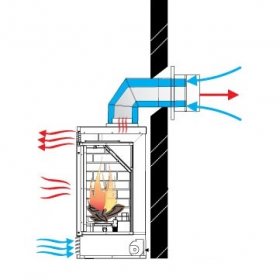
Heat in the house is the main component of coziness and comfort. There are many ways to heat your home. And if for apartment buildings this is centralized heating, then the owners of their own houses prefer to install a variety of boilers. Fire heaters cannot do without a smoke exhaust device. Traditional pipes are being replaced by new, more advanced equipment. A growing number of homeowners are deciding to install a coaxial chimney, a more practical and efficient smoke exhaust device.
Content
What is unique about coaxial design?
The concept of “coaxial” implies the presence of two objects inserted one into the other. Thus, a coaxial chimney is a double-circuit design of pipes of various diameters located one inside the other. Inside the device there are jumpers that prevent the parts from touching. The equipment is installed in heat generators equipped with closed combustion chambers. These include, for example, gas boilers.
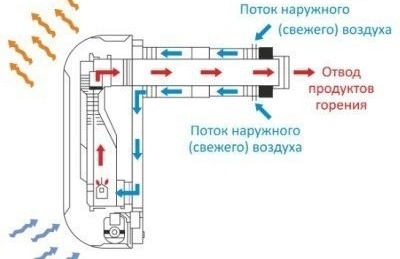
The coaxial chimney is designed so that the inner pipe is designed to divert combustion products into the atmosphere. The larger outside diameter is used to supply fresh air for combustion.
Thanks to the special device of the standard coaxial chimney, it performs two functions at once: it creates an uninterrupted flow of air necessary to ensure the combustion process, and takes the combustion products out. The length of the device most often does not exceed two meters. It is mainly intended for horizontal location and is displayed on the street through the wall. Less commonly, you can find a structure brought out through the ceiling and roof.
The special design of the coaxial chimney allows it to function according to a completely different principle from a conventional device. The oxygen required for combustion enters the boiler from the outside. Thus, there is no need to ensure a constant flow of fresh air into the room by airing, which is inevitable for traditional smoke exhaust channels. In addition, a number of problems typical of standard chimneys have been successfully solved:
- Reduction of heat losses due to heating of the incoming air from the outside from the internal pipe exhausting hot smoke, which results in a higher efficiency of the system.
- Reducing the risk of fire in the contact areas of flammable surfaces and the flue duct, since the inner pipe, giving off heat to the outside, is cooled to safe temperatures.
- The high efficiency of the system allows for complete combustion of fuel, so unburned particles are not emitted into the atmosphere and do not pollute it. A boiler equipped with a coaxial chimney is environmentally friendly.
- The combustion process, including the supply of oxygen and the removal of gases, takes place in a closed chamber. This is safer for people, since hazardous products of combustion do not enter the room. Therefore, the arrangement of additional ventilation is not required.
- Save space due to the compact size of the device.
- A wide range of chimneys designed for various power systems.
Features of the installation of such a chimney system
There are two main types of arrangement of coaxial flues: horizontal and vertical. The direction of the flue channel is determined individually for each boiler. It must be borne in mind that horizontal devices are installed only if a heater with forced ventilation is used. Moreover, according to SNiPs, the maximum length of the horizontal section of the coaxial chimney should not exceed 3 m. However, some manufacturers set other restrictions for their products. Therefore, before designing a structure, you should carefully familiarize yourself with the characteristics of the device.
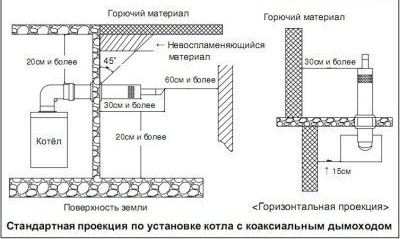
With proper design and subsequent installation of a standard coaxial chimney, it is imperative to take into account the dimensional parameters that are indicated on the diagram
Vertical ones are used if, for a number of reasons, it is impossible to equip a flue outlet to exhaust smoke directly through the wall: closely located windows, a small street width, etc. The installation of a coaxial chimney can also be done obliquely. We begin the installation of the system with the correct selection of the device.
According to the installation standards of the internal coaxial chimney, the diameter of the boiler outlet should not be larger than the diameter of the outlet channel. Be sure to control this moment by checking the passport of the chimney, where its diameter is indicated. Connection to the boiler is carried out using a bend, tee or pipe. In this case, each subsequent element is attached to the previous one so that there are no obstacles to the removal of combustion products.
The list of elements required for installation depends on whether the outlet pipe is located on the side or at the top. In the second case, the chimney will be easier to output. For the first option, a horizontal assembly of device parts is used. The design is displayed in a vertical position using brackets of various modifications. For the installation of coaxial pipes, a special adapter is used. In this case, the clamps rigidly fix the section of the junction with other elements. The use of home-made adapters and extension using tape winding and applying sealant is unacceptable, since this is a very unreliable and unsafe option.
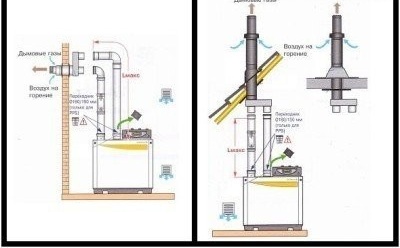
The outlet pipe can be located both side and top relative to the heater. In the first case, the mandatory presence of a horizontal section is assumed
When installing a coaxial chimney, remember that the outlet pipe must be at least 1.5 m above the heater. The outlet of the pipe is arranged at an angle of at least 3 °, so that condensate flows freely. In addition, the exit of the coaxial chimney is best placed at a height of not less than 1-1.5 m above the surface, otherwise it may become clogged. If a complex system is mounted, then its total length should be about 3 meters.
Requirements! In the design, the simultaneous presence of more than two knees is undesirable. There should be a distance of about 60 cm from the outlet pipe to the nearest windows, and at least half the diameter of the outer chimney pipe to the gas supply pipes.
Fragments of the structure should fit very tightly and enter into each other at a distance of not less than half the diameter of the channel section. To bypass the chimney around an obstacle, we use special elbows with different angles of inclination. It is possible to use two elements at once.
The most important area of work is the roof. Here it is required to carry out work to ensure maximum fire safety of the structure. To do this, we use special insulating pipes, we fix non-combustible insulation and be sure to leave an air gap between the ceiling and the pipe. Based on the requirements for the installation of coaxial chimneys, in order to avoid possible contact of the flue channel with various objects, special protective covers are used. If the chimney is led out through the roof, then the outlet is carefully sealed and covered with a special apron, which should well cover the junction. If through the wall - any non-combustible materials. Coaxial chimney is always cold - this is one of its distinguishing features.
Sometimes homeowners complain of icing up the chimney when mounted horizontally. In this case, you must use special protection:
You should know that for each heating appliance its own chimney must be mounted, "combination" is unacceptable.
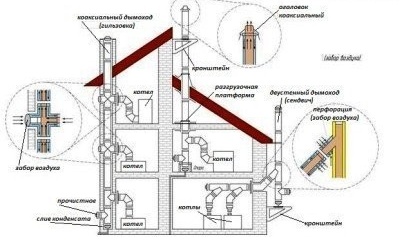
Coaxial chimney must be equipped individually for each heater. However, with proper design, a cascade connection option is possible.
Coaxial chimney - an active design that improves fire and environmental performance of heating boilers, as well as increasing their efficiency. Installation of the device can be done independently, however, if there are doubts about your own strengths, it is better to entrust this very responsible work to professionals. Indeed, as practice shows, the installation of chimneys requires skills and compliance with safety precautions, and the competent installation of revisions or condensate drains without the help of specialists is practically impossible.
